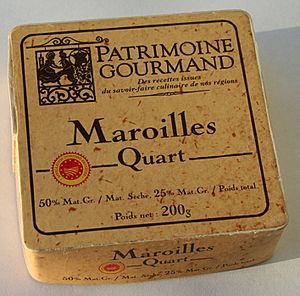Maroilles cheese facts for kids
Quick facts for kids Maroilles |
|
|---|---|
 |
|
| Other names | Marolles |
| Country of origin | France |
| Region, town | Aisne and Nord |
| Source of milk | Cows |
| Pasteurised | Yes (industriel) No (fermier) |
| Texture | Soft cheese with washed rind |
| Aging time | 2–16 weeks |
| Certification | French AOC 1976, AOP 1996 |
| Named after | Lua error in Module:Wikidata at line 70: attempt to index field 'wikibase' (a nil value). |
Maroilles (pronounced "mah-RWAHL") is a famous French cheese. It is also known as Marolles. This special cheese comes from the northern parts of France, in regions like Picardy and Nord-Pas-de-Calais. It gets its name from the small village of Maroilles, where it is still made today.
Contents
What is Maroilles Cheese?
Maroilles cheese is sold in rectangular blocks. It has a moist, orange-red outer layer called a washed rind. This rind gives the cheese a strong smell.
The most common size of Maroilles is about 13 centimeters (5 inches) square. It is also about 6 centimeters (2.4 inches) tall. This size usually weighs around 700 grams (25 ounces).
There are also three other official sizes for Maroilles cheese:
- Sorbais – This is about three-quarters the size of a full Maroilles. It is 12 to 12.5 cm (4.7 to 4.9 inches) square and 4 cm (1.6 inches) tall. It weighs about 550 grams (19 ounces). This size needs to age for at least 4 weeks.
- Mignon – This is half the size. It is 11 to 11.5 cm (4.3 to 4.5 inches) square and 3 cm (1.2 inches) tall. It weighs about 350 grams (12 ounces). This size needs to age for at least 3 weeks.
- Quart – This is a quarter of the size. It is 8 to 8.5 cm (3.1 to 3.3 inches) square and 3 cm (1.2 inches) tall. It weighs about 180 grams (6.3 ounces). This size needs to age for at least 2 weeks.
History of Maroilles
People believe Maroilles cheese was first made a very long time ago. It is said that a monk in the Abbey of Maroilles created it in the year 962.
This cheese quickly became very popular in the area. Many French kings loved Maroilles cheese. These kings included Philip II, Louis IX, Charles VI, and Francis I.
How Maroilles is Made
Making Maroilles cheese involves several steps. First, the fresh cheese curds are shaped and salted. Then, they are taken out of their molds. They are placed in a special drying area for about ten days. During this time, a light layer of good bacteria starts to grow on the cheese.
Next, the cheese is brushed and washed. After that, it is stored in a cellar for at least five weeks. Some cheeses are kept for up to four months. While in the cellar, the cheese is regularly turned and brushed. This helps to remove any natural white mold. It also allows red bacteria to grow, which changes the rind from yellow to its famous red color.
The finished Maroilles cheese has at least 45% fat. It can be made from pasteurized milk or unpasteurized milk. In 1976, Maroilles received its special French certification called AOC. This means it must be made in a specific way and region. In 1996, it also received AOP status, which is a similar European certification.
In 2005, over 2,100 tons of Maroilles cheese were made. Most of it came from large producers. A smaller amount was made by about ten smaller, traditional farms.
Cheeses Like Maroilles
There are other cheeses made in northern France that are similar to Maroilles. They are often called the "Maroilles family" of cheeses. These cheeses are made using similar methods.
Some examples include:
- Baguette Laonnaise (from Laon)
- Boulette d'Avesnes (from Avesnes-sur-Helpe)
- Boulette de Cambrai (from Cambrai)
- Cœur d'Arras (from Arras)
- Cœur d'Avesnes (from Avesnes)
- Dauphin (from Nord)
- Gris de Lille (from Pas-de-Calais)
- Guerbigny (from Picardy)
- Rollot (from Somme)
Maroilles in Popular Culture
Maroilles cheese was featured in a very popular French movie. The 2008 film Bienvenue chez les Ch'tis (which means "Welcome to the Sticks") joked about the strong smell of Maroilles cheese. This movie helped make the cheese even more famous.
See also
 In Spanish: Maroilles (queso) para niños
In Spanish: Maroilles (queso) para niños


